Celebrating heritage and embracing change



Amerindian Heritage Month celebrations are in full swing and the village of Rockstone is no exception. Villagers are in preparation for their upcoming heritage celebrations later this month (Japeth Savory photo)
Sunday, September 17, 2023

COLLEEN Savory is more than just a teacher. She is a mother, a sister, a wife, a friend and a mentor to many people she comes in contact with.
She is a veteran teacher who invested 30 years in public school at the primary level and takes her role as an educator seriously.
Equipped with a no-nonsense attitude and the willingness to adapt to any situation, Savory told the Pepperpot Magazine that teaching was indeed a calling, and she is happy about the life decision to become a teacher.

The mother of two added that she is a staunch member of the Central 7th Day Adventist Church at Oronoque Street, Queenstown, and she is the sabbath teacher.
Savory has been married to Andre Blackman, a retired policeman, for the past 24 years and they reside at Eccles, East Bank Demerara.
On November 8, 1993,Savory embarked on her journey as a young teacher and started teaching at J.E. Burnham Primary School at William Street, Kitty.

She spent three years there and moved to St. Pius Primary School on September 1, 1996, where she taught all grades at the primary level.
Presently, she is a Grade 3 teacher at the transition level and the Divisional Supervisor for Grades 3 and 4 for the past 15 years.
Growing up, she always wanted to teach and mould minds; whenever she had company at home, especially children, she would gather them up. Shemade it into a learning session with Bible verses and was serious about it, equipping herself with a whip and would use it if she had to, she said.
Initially, her first career choice was to become a computer consultant and to travel the world to conduct lectures, but she fulfilled her true calling of becoming a teacher, and it was a good choice since she never regretted it.
“I love teaching. The little things matter to me, the pep talks with the children, the hugs and smiles from their little faces certainly brighten my day and it is quite rewarding when you love what you do. It is not a burden at all. I take my role as a teacher very seriously and I enjoy it,” she said. Savory likes the thought of taking the children from the known to the unknown via classroom teaching through varying methods to make learning fun and focus more on literacy and numeracy.
She related that with the advent of technology it could be incorporated into teaching phonics if used effectively and
in the right way.
The veteran teacher told the Pepperpot Magazine that she and the team of teachers initiated a summer programme for slow learners, which was well-received.

Savory reported that following the pandemic took a toll on them and no one was prepared for it, so when face-to-face learning resumed, some pupils were left behind academically and had to do something to engage the children.
She related that phones were used to promote teaching, then online teaching was initiated, and it targeted the greatly affected pupils.
Savory disclosed that the team of seven teachers came together and pitched the idea to the head teacher and gained her approval to launch a reading camp here at the school focusing on literacy and numeracy.
She stated that the idea was accepted by the Ministry of Education for six pupils initially for five weeks, free of cost, but when the others found out about it, they received an overwhelming response to join.
They had to accommodate 100 pupils in the reading camp from July 17 to August 17, 2023, and it targeted children who gained less than 50 percent marks on the annual exam.
Savory reported that they had multi-grade teaching in all grades and she is a Grade 4 teacher of children between the ages of 8 plus to 9 years old and the foundation must be laid
at the primary level for pupils to move onto secondary schools.
On November 8, Savory will celebrate 30 years in the noble teaching profession and says if she had to, she would repeat because of her love for teaching and all it entails.
“School is a comfort zone for some children. They look forward to be pampered by teachers and to be called ‘pet names’ and it is due to my years of experience I would know when something isn’t right with a child. Their facial expressions and body language say it all and I don’t push, I wait, build trust and eventually, the child will open up and say whatever it is,” she explained.
Savory related that due to the confidentiality between teacher/student, they do not reveal certain things but work with that child to have solutions since abuse isn’t just physical anymore. It is also emotional.
The teacher added that they play a very critical role in the lives of learners, and they must remain professional and fulfill their duties.
Savory stated that they have to develop newer ideas through teaching aids to make learning in the classroom fun and interesting, making school a place the children want to be despite what they are going through in the home environment.
“Showing love to the children at school is very important. It breaks barriers and they are more focused there is a need for more male teachers in schools because the boys would feel more comfortable to relate to them better. I think the Ministry should make the package more attractive for male teacher to be in schools, their role is vital,” she reasoned.
Savory related that moulding minds is a two-part affair that involves parents/teachers and their lack of cooperation/ participation in school events is very evident and they need to play a greater role in the welfare and interest of their children.
She is however, thankful for the Ministry’s through the National Centre of Educational Resources Development (NCERD) programme in her school which is called Innovation, Excellence and Leadership to suit every child’s academic capability to boost learning.
Savory stated that it is quite worrying that children at the primary level have unlimited access to the internet without parental guidance and censorship, causing them to see things they are quite not ready to and calls the cellbphone “a classroom with boundaries”.
SEVERAL hotels in Guyana have pledged their sup-
indigenous artisans. She reported that she has a wide variety of craft, all hand-made by herself
possible.
Patterson would commute from her village a few times per week to sell all Amerin-
yond Heritage Month.
Meanwhile, Herdmanston Lodge Events Manager, Crystal Baptiste, told the
Pepperpot Magazine that management agreed to accommodate Janet Patterson many years ago and will
continue to do so. Since there isn’t a lot of space for more artisans, Baptiste related that they can
port to accommodate artisans in an effort to promote our culture and tourism in designated spaces at their hotels, not only for this month but throughout the year.
Herdmanston Lodge, located in Queenstown, Georgetown was the first to host a handicraft maker, Janet Patterson, who hails from Santa Aratack, Region Three (Essequibo Islands-West Demerara).
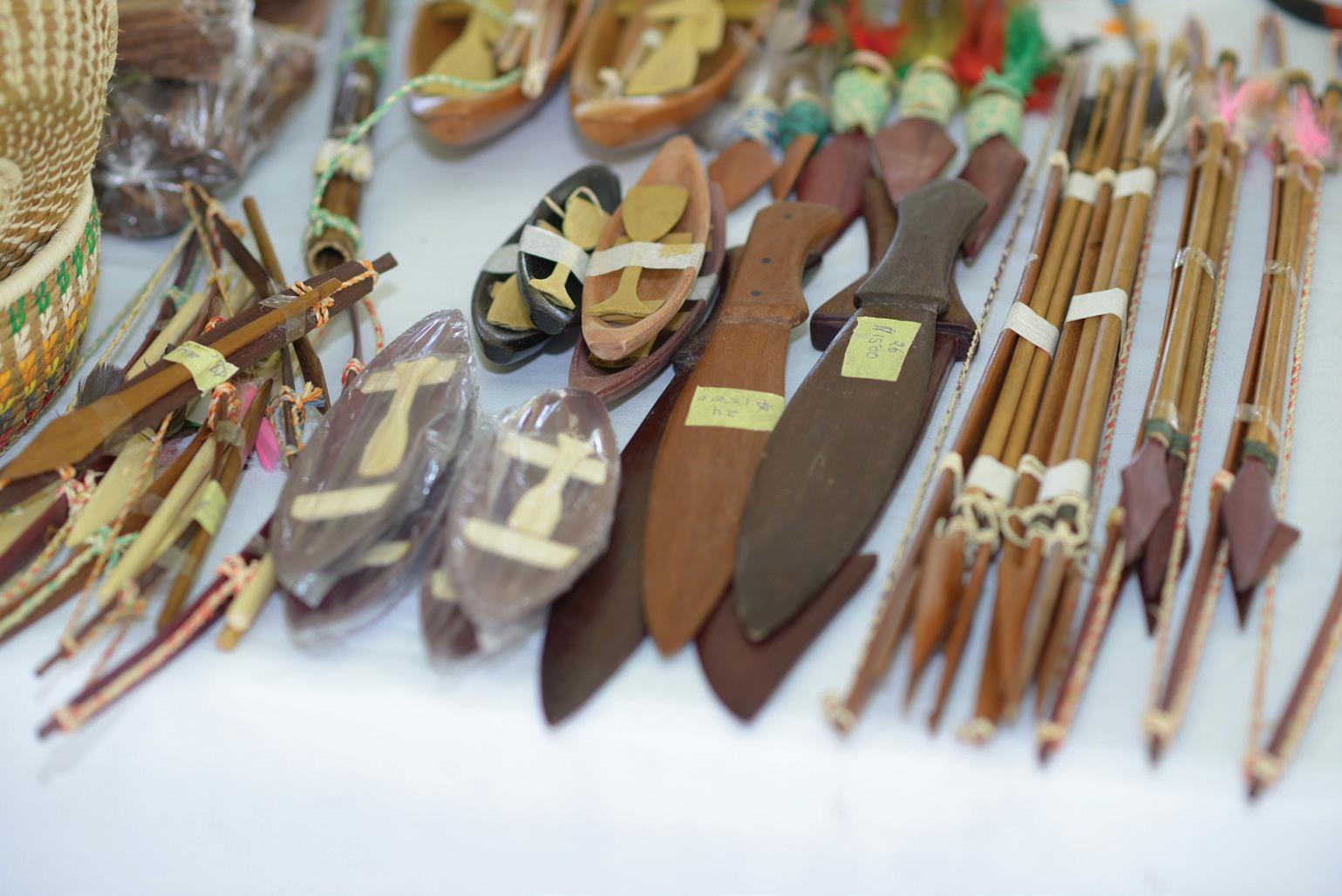

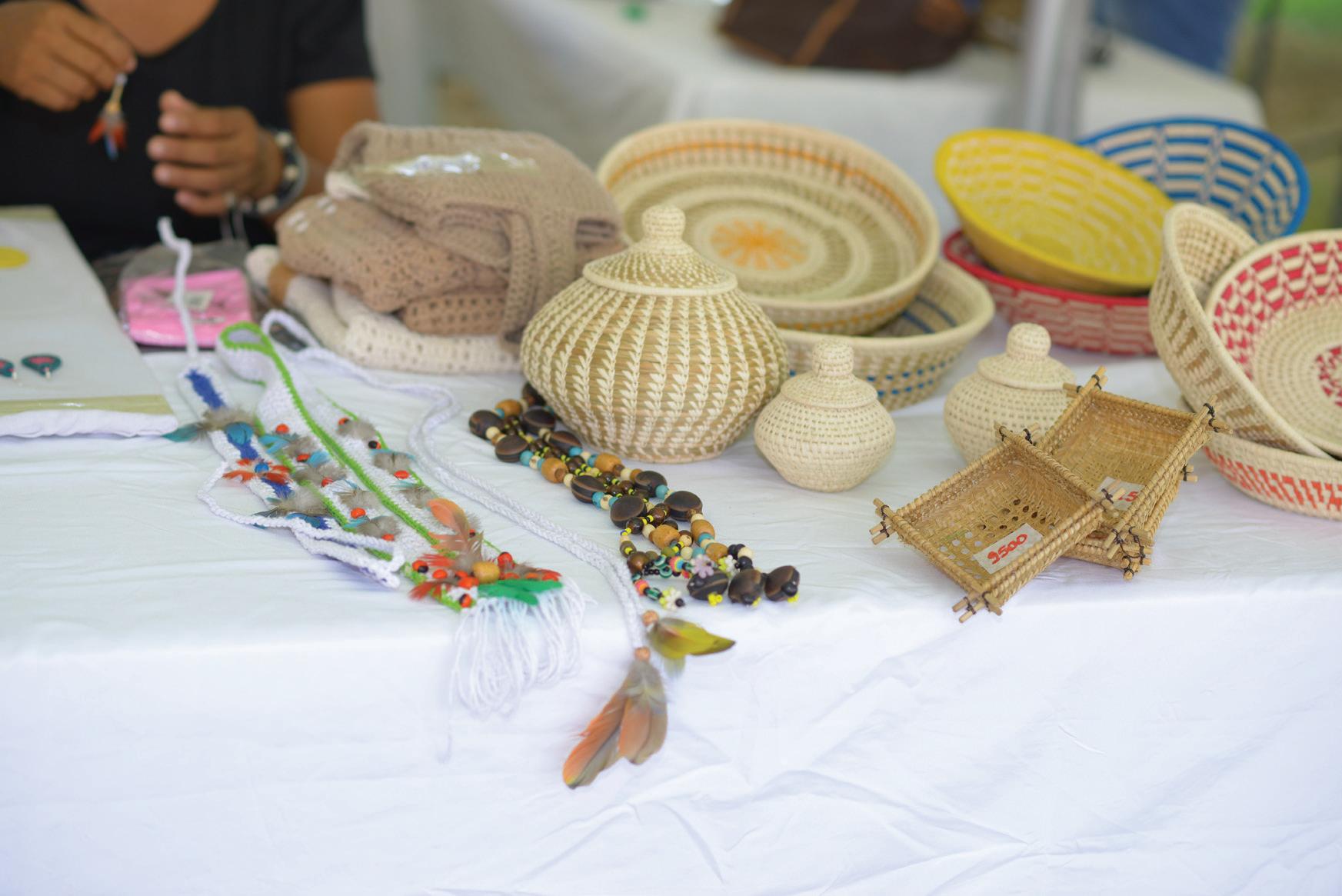

Patterson told the Pepperpot Magazine that she has been at Herdmanston Lodge for more than 10 years and she is allocated a little space to display and sell her products and those of other
and others, including jewels, hammocks, fans, purses, baskets, bags, jewel boxes and other keepsakes.
“I feel happy and pleased that I can showcase my products and that of my people at such a prestigious place where both locals and visitors frequent,” she said.
Patterson told the Pepperpot Magazine that she would sell products from the people in Santa Aratack and other suppliers and has been doing it for many years.
She has been promoting arts and crafts for as long as she can remember and says she has a few years left in her and will continue to promote their heritage for as long as
dian products at Herdmanston Lodge and participate in exhibitions including the Amerindian Village at Sophia earlier last week.
She came from a family of artisans and is happy to continue the tradition of making and selling indigenous products.

Patterson stated that it is challenging to commute and costly, and she does it as much as she can.
She is of the view that more hoteliers should accommodate artisans to showcase and sell their products at their hotels across the country be-
SEE PAGE XIII
IN today’s society, many aspects of Amerindian culture, including their dialect, rituals, practices, and languageare still practised in today’s society.
The Pepperpot Magazine spoke with Kaphon Hastings, an advocate among the Amerindian peoples, who spoke particularly about the importance of the perseveration of the Akawaios’ dialect, cultural practices, and rituals.
Hastings believes that Amerindians must truly embrace their culture.“We are not at the point where we need to be culturally, and the onus is on our people to get to that place,” Hastings said. “I am trying to revisit parts of my culture through academic means or cultural means, or maybe through having more deliberate conversations with community leaders, especially my community leaders, but on a large scale, we are rediscovering what was lost.”
Hastings hails from an Amerindian community in the upper MazaruniRegion in region 7 Cuyuni/ Mazaruni.He describes himself as the go-to person when it comes to Amerindian culture.


According to him, the Amerindian communities must continue to place a strong emphasis on their language and have a great knowledge of who they are as a people. For most Amerindians, their language speaks greatly to their personalityand they needto see themselves for who they are as a people.
During Sep-

tember, which is referred to as the dry season, there is the traditional practice of poisoning where the ponds and creeks will start to dry up.
“You have a lot of poisoning activities being done, it used to be a lot more than now, but you still have some that happens, even this year. Nevertheless, it is one of the main things that Akawaios do around this time,” he said.
According to Hastings, plants play a major role in Amerindian culture. It is embedded in their ritualistic practice.
“Here now, they use tubers, but when compared to other Amerindian groups like the Arawaks, you might have a slight difference because the Arawaks now mostly use leaves, which has a similar effect on fishes. The practices are the same. Since Agriculture plays a major role in their lives, the Akawaios look at plant behaviour,“ Hastings told Pepperpot.
Another practice that is prevalent this time is the spawning of sardines. This is a practice where Akawaios look at the level of the creeks and take opportunities for their investments.
But for those who are ritualistic, he noted that the tradition is still practised among the older Amerindians where the use of the traditional plants is observed.
All aspects of Amerindian culture considered, Hastings impressed that as a part of the culture, much emphasis should be placed on not only preserving Amerindian culture but to also find ways to make them recognised in modern times.
GUYANA has many personalities and people who have put the country on the world stage ever since we became independent.

These were sentiments expressed on occasion to honour Rudy (Boysie) Bishop, a musical icon, legend, and leader of the Chronicle Atlantic Steel Orchestra. The Pepperpot Magazine sat down with the musical legend to discuss his life, music, and legacy.
Rudy Bishop M.S is a man and a movement. He is actively pursuing life goals, and as he puts it, “neither chronological nor biological circumstances can derail” them.
“Cap”, as he fondly called, which is the abbreviation for captain, is the first son of 14 siblings and was born on February 5, 1945, in Kitty in the capital city of Georgetown.
Bishop told us that he was just a teenager when he developed his natural talent for music.
“From the first time I heard it, I developed a natural affection for steel band. I could resist the urge to embrace the pan, as the medium through which I couldn’t express my power, purpose, and presence in this life. I grew up at a time and in a culture where my parents decided their children’s professional pursuits,” Bishop recalled.
Bishop shared that though he was encouraged to follow his dreams as a pan-player, his father had preferred himto have a sound academic education for his son’s security.
The music legend noted that when conflict often developed, he was flogged for opposing his father’sstrict guidelines against his compulsive associationwith the steel band. However, the music legend managed to preserve his passion.
According to him, he pursued his passion and became an arranger, composer, director, and creative genius.
He played Guyanese folk music, regular pop songs, and international classical pieces all on the pan.
Rudy recalled that it was his exceptional abilities and skills in pan music that led him to a swearing-in ceremony at Parliament, where he was sworn in as a cultural representative and subsequently received the Medal of Service award.

Honoured at a simple ceremony
Recently, Rudy Bishop was honoured as he celebrated 50 years in the music business. Among them was a veteran broadcaster and proprietor of Guyenterprise Company, Vic Insanally, who recalled the days of Bishop and himself growing up in Pike Street, Kitty as small boys.

“To me, tonight it is like a reunion of seeing someone who has done so well come back and celebrate with us. Boysie, my friend for so many years, just like Eddie Grant hails from
Plaisance, Boysie hails from Kitty.
In those days, when the train was running, it made two stops, Plaisance and Kitty, when the train left its terminal at the corners of Lamaha and Carmicheal Streets,” Vic recalled during his recount of the good old days.
He recalled that when he went to live in Kitty with his mom and six siblings, he became closely knitted together with Boysie, who lived not too far from him with his family. Boysie’s family comprised 14 siblings.
Vic recalled that there were hard days but happy days, and everything that was needed was provided.
Vic’s recollection of Boysie was that he came from humble beginnings and a very religious family.
The name Atlantic came because Bishop used to practice with the band on the seawall, Vic noted during his recollection.
Meanwhile, Former Mayor and, at that time, Guyana’s
Prime Minister, Hamilton Green, also shared some memories of growing up with this music legend.
“Rudy came to my attention many years ago when the steel pan was regarded as a second-class function. Rudy took the steel pan to a higher level; he introduced what he called the brass and steel, but Rudy’s vision resulted in music of tremendous beauty and universal acceptance. Rudy and others produced music that has brought to people in every continent of the world,” Green noted.
In his acceptance speech, Rudy noted that sports and culture have no allegiance to anyone.
Bishop also noted that for him, in training his band members, many of whom are teenagers and those who have gone into the world and made a name for themselves, “education is the key and it is critical to possess if you are going to stand out in this world.”
AMERINDIAN Heritage
Month 2023 is being celebrated under the theme “Sustaining our cultural heritage while contributing to one Guyana.” This theme is an idea that the village of Rockstone stands by and for. Rockstone is one of Guyana’s many captivating villages located along the right bank of the Essequibo River, with an estimated population of 300 people.
The village of Rockstone has a large indigenous population, a Toshao and is granted and governed by many of the same laws and acts as Guyana’s other Amerindian communities. But in Rockstone, villagers of every ethnic group could be found. In a place where many people have come to call home and now live, Rockstone is the true embodiment of One people, One nation and One destiny.

The village’s Toshao, Flagan Carter, spoke to the team and he expressed that Rockstone is, undoubtedly, an Amerindian village and having people of different ethnicities present takes nothing away from the village, but rather adds to the unique cultural blend the village has procured and what has captivated visitors over the years.
The enchanting little village of Rockstone will be hosting its Heritage Month celebrations on September 24. The village’s Toshao, councillors and villagers are planning to host an event that will bring out the villagers and draw visitors into the

different to an extent. Some persons would have lived here for years; their grandfather would have lived here. Their cousins would have come and so forth. We’re not against anybody; even in the past years, we have seen more people come into the village.”
The argument that is often made in the cases of villages that are becoming diversified is whether culture is lost through integration. On this front, Toshao Carter expressed that not only is integration a good thing, but it is also inevitable. “I think the more we integrate, the better it is
country is being integrated. And Rockstone is not one of those that is limited to that integration,” he said.

Many people think it captivating, that heritage is celebrated in a village as diverse as Rockstone. But as Toshao Carter explained, Amerindian heritage celebrations are Rockstone’s cultural celebrations. “Come at heritage time, everybody is going to be out there. Black, red, blue people are going to come up from Linden and everybody is going to be one big metem pot ensuring we are going to have a good time,” he said.
and will then see a variety of activities, ranging from Paiwari drinking to watermelon eating and cassava across the water as well as a warashi race and best-dressed competitions for all ages.
The community of Rockstone is working towards becoming a village where culture, diversity and change are embraced. Toshao Carter expressed that, “One of the things we are doing from our village plan as well is that we are sharing from the village level. We are having classes on
village. Tourism plays a big role in the village; they are always open to new people, things and changes.
When asked what a village means to him, Toshao Carter stated that, “The simplicity of it is where people with a heritage or background are living together. Based on the act as well it says that a group of people that are in a village that have similar views, ideas and ideology and they have a history, that is the simple definition.”


The diversity, coupled with the culture of Rockstone, makes for a very interesting discussion among those who visit the community. The Toshao explained that, “I think it’s like a nice pot of metem. You got some eddoes, you got some cassava, you got some plantain. All of these things look different. They even taste
for race relations throughout the length and breadth of the country. Even this idea of just being Amerindian or black, it speaks to not the best representation. I think integration is better and I think every village throughout the length and breadth of the
This sentiment is echoed throughout the village. In the fact that although they may not always see eye to eye on all matters, they are still a community. And one that celebrates each other and does it together.
In describing Rockstone’s heritage plans, the Toshao explained that the occasion will have a little bit of everything, just like the village itself. The event will kick off with a cultural presentation
language, dialect, culture, crafts and so on. I think that will help preserve some of that. Will it eliminate the transformation the entire world is going through for every culture or every civilisation? I don’t think it will.” The Toshao said that as much as transformation and change can’t be stopped, it can be embraced by people who know their culture, sharing it with the rest of the community.
HAVING an idea of where you would like to see things go for yourself is something that most people have. But having a vision for where you would like to see your community progress takes a unique interest and passion for one’s village and the people that live there. The village of Rockstone is located almost 17 miles from the mining town of Linden and stretches to connect to the right bank of the Essequibo River. The village in known and widely revered for fishing. Rockstone is in
things that must be put in place for Rockstone to reach its potential as a village that will draw people from every corner. But the move forward takes leadership, cooperation and a vision. And people like Deino Williams are important to ensuring their communities and villages reach new heights.
Deino Williams is an ambitious 24-year-old who was born and raised in the village of Rockstone. Today, he sits on the village’s council and is being seen by his community as the village’s next potential Toshao. But before he became councillor at just 19,

granted me a scholarship through the government. I was actually the first scholarship [recipient] for the village….” He went on to express that many people of his village still look up to him and many urge him to run for the position of Toshao. Deino said that he was considering running in the village’s next election which will be in January of next year. But for now, he has a whole host of ideas and thoughts he would like to implement in the village of Rockstone.
fact the only place in Guyana where ‘Fish Festivals’ and ‘Fish Extravaganzas’ are hosted. Rockstone also neighbours the beautiful and majestic Gluck Island. With waters teaming with arapaima and Gluck Island being home to more than two hundred species of birds, including our country’s national bird, Rockstone has the potential to be one of the nation’s biggest tourist destinations. But there are still many steps to be taken and many

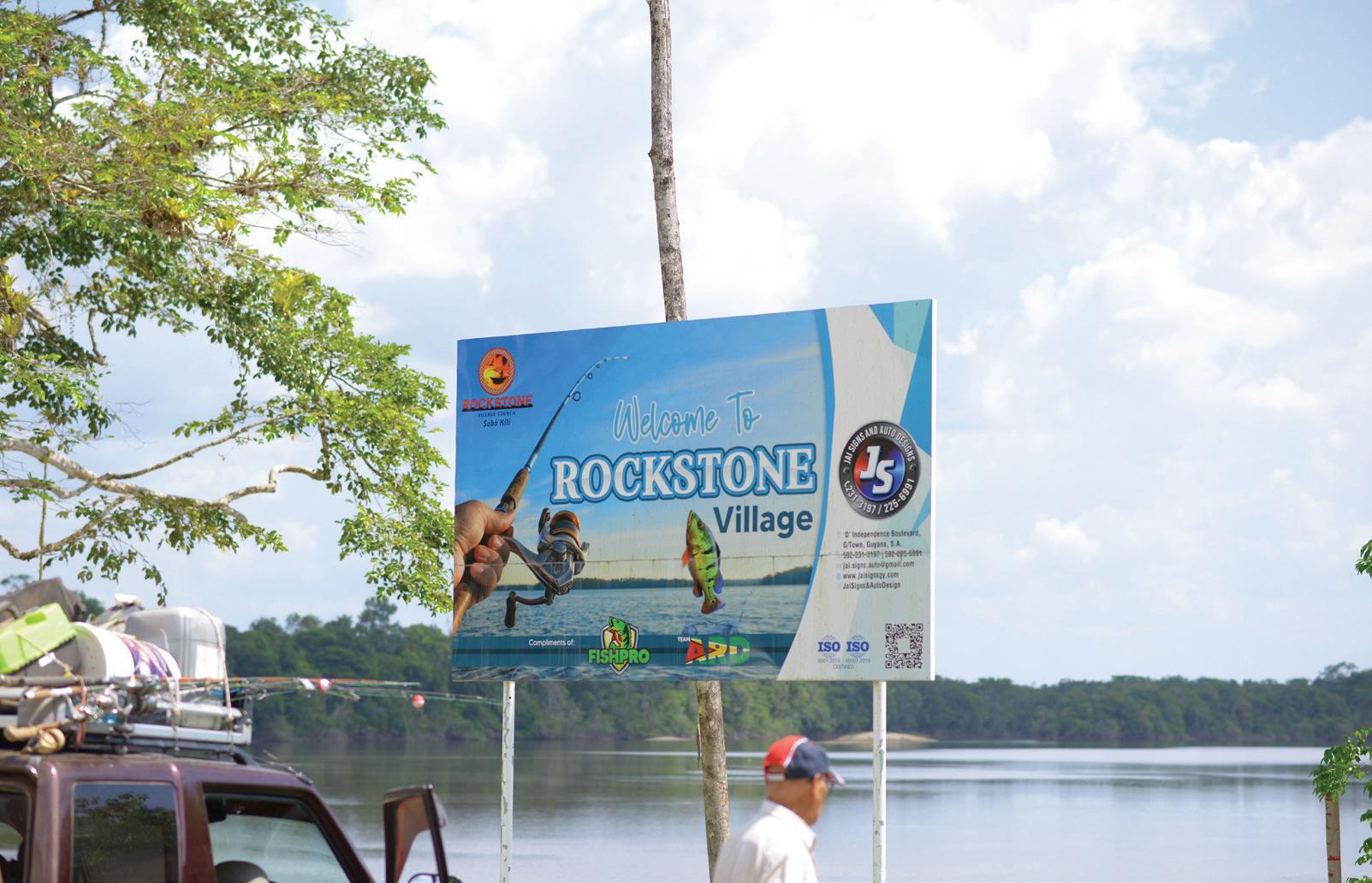
won a scholarship and began advocating for the issues his people face, he says growing up in Rockstone was a oneof-a-kind experience and one that shapes his beliefs.
Deino grew up as the middle child in a family of 7 siblings. He stated that his upbrining was different because he was given opportunities and he sought to grasp as many of them as he could. “To me, growing up in Rockstone was a unique experience. They
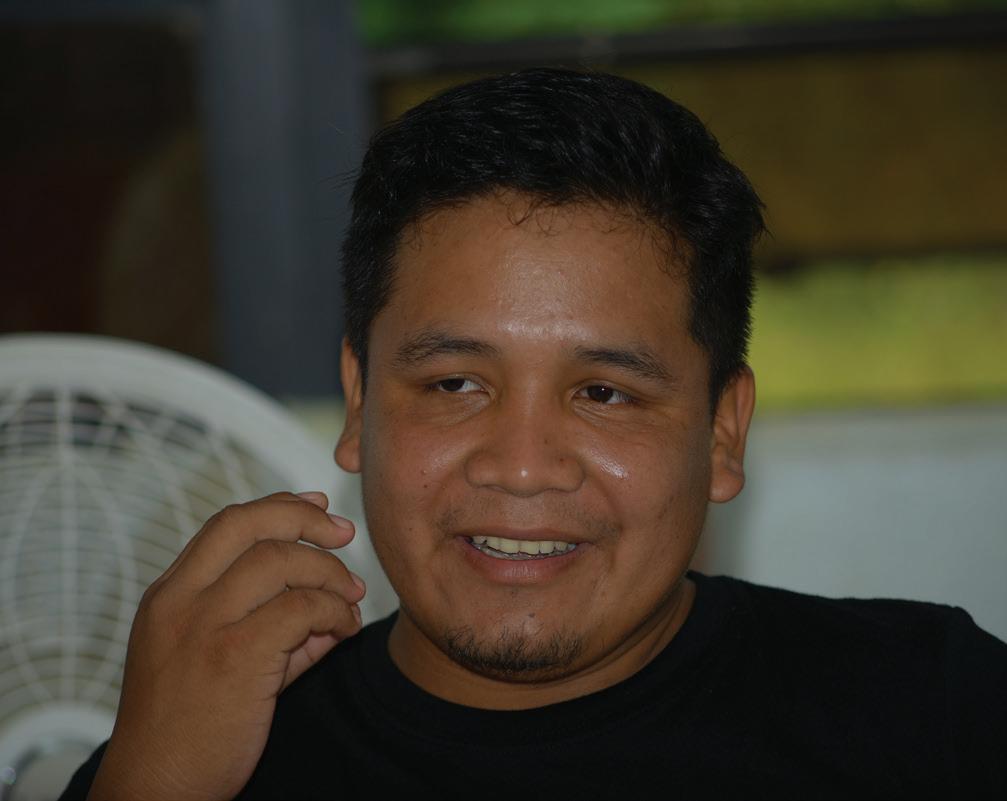
As much as Rockstone is known for tourism, Deino believes that far more could be done to showcase Rockstone and all of its wonders to the rest of the world. To Deino, Rockstone has the potential to become the tourism hotspot he envisions it to be. “Rockstone has great potential for tourism. Through the government and the LCDS [Low Carbon Development Strategy] we have decided to establish Eco lodges. The fish extravaganza or fish festival has been the major attraction in the year,” he said. Deino went on to express, “To me, we should take all the money and invest it in tourism. Because I see this as something that could bring back revenue into the village, create jobs, especially for the young women.”
One of the aspects that Deino considers as having untapped potential is the Gluck Island. Deino believes that if the village really wants to go the route of eco-tourism, then a place like Gluck Island is the place to start.

“We are planning on creating tours that will attract foreign tourists plus domestic tour-
ists. Any person who shows interest, we have birdwatching in Gluck Island. It is actually one of the largest islands in the Essequibo River and it is rich in biodiversity. It has more than two hundred different species of birds. So, if we want to start with eco-tourism, why not start there?” he said.
The village is taking a number of big steps into the field of tourism. The real intention and aim of activities like the village’s various festivals is to bring money to the village and its people.
As Deino explained, “Last year, every villager that took
part in the fish extravaganza made a profit by selling and so forth. The village actually made one million and something dollars in profit. And that is the true intention of the fish extravaganza.”
His ideas and visionary approach to the development of his village are perhaps among the many reasons why his peers look up to him. Among other things he would like to see done are in the area of the empowerment of women and girls. Deino says that, if given the funds and resources, he would build a home for victims of domestic violence.
Deino went on to state that, “How can you try to solve domestic violence and you are still in the same home. That is part of my vision: a woman experiencing domestic violence in her home, we can say, we’ll take you away from this home.” Deino urges all of his fellow young people to take opportunities for self-improvement. As he stated, “I would tell young people, take these opportunities seriously, don’t refuse knowledge. And it is something that needs dedication, determination and discipline.”
ROCKSTONE, the village’s name, is quite literally derived from the fact that the community sits in a granite boulder. On the right bank of the Essequibo River, the village of Rockstone is a beautiful and enchanting little village. Rockstone’s landscape is primarily hilly, with buildings like the school built to suit the terrain. Rockstone is known for a few things: its fish festivals, its people and its culture.

Rance Allicock came to settle in Rockstone in the year 1997 and hasn’t left since. He was among the first people to call Rockstone home. The sight of Rockstone some 20 years ago was quite different from what is seen today. Rance hails from Annai in Region 9. His mother comes from Region 8 and his father from Linden. Rance grew up with the potential and willingness to pursue careers in health and agriculture but was unable to because of financial restraints. Rance was led to Rockstone where
he started and maintained a life to become a pillar of his community.
Rance came to the village of Rockstone through a series of events that led him into the village. The spritely 76-year-old remembers the old Rockstone that he came to call home. Like many of its neighbours at the time, Rockstone was once involved in bauxite mining.

Rance, who also served as the village’s Toshao for a time described how Rockstone, despite the many activities happening in it, has always been a simple village with humble people. He stated that “Rockstone got it’s original name from the huge granite rock that is down on the landing. So the older people decided to call it Rockstone.”
According to Rance, the village of Rockstone was like an undiscovered wilderness. “It looked like the first time going into the forest. It was like doing exploration. You just looking at spots, you’re looking at valleys, you’re looking at mountains. Thinking about where is the best
place to put up our camp.”
This mindset and cooperative approach played an integral role in the development of the village of Rockstone. The community’s school was built by members of the village. As Rance stated, “This school was the first school and it was a shingle building. And we built it ourselves and we had to ‘dig-a-way’ the mud. We had about two hundred people. Today it’s about three hundred.”
Rockstone, however, from Rance’s point of view, has developed drastically over the years from a small village of people who were just looking for a place to call home to a community that works together for the development of Rockstone. Rockstone today is a village onto itself, with its own schools, health centre and guest houses. The village, however, is still facing one if the biggest issues: unemployment.
One of the issues facing the village of Rockstone is unemployment. Being primarily a logging and farming community, many villagers are finding other alternatives
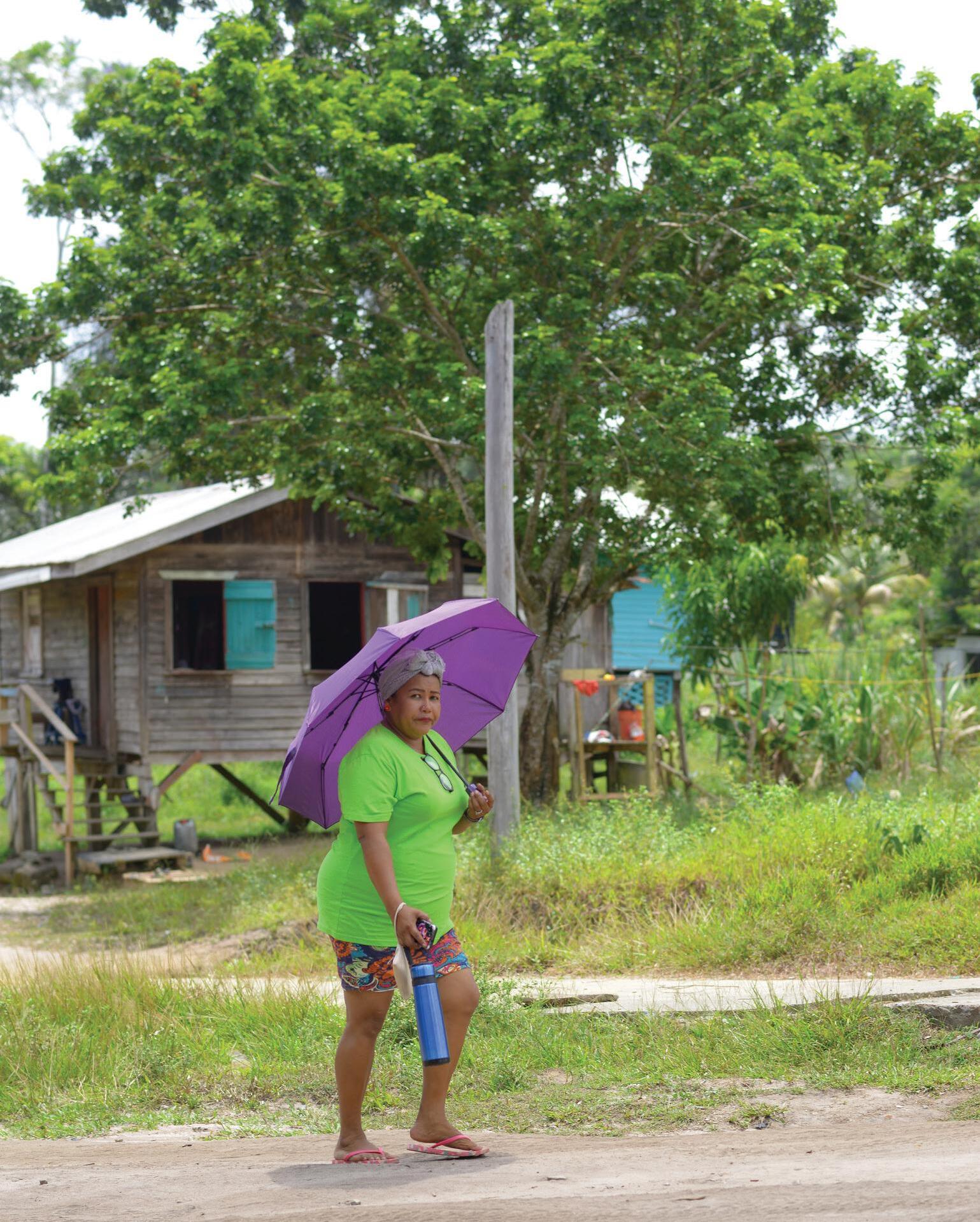
to make a living. Going into the village of Rockstone on a Monday would see most of its villagers out in places like Linden, working. Most of them for the entire week before returning home on the weekends.
As Rance explained, the lack of employment opportunities has become what he calls a disease. “Right now, people are doing farming. Not extensive farming but self-sustainable farming as well as fishing and hunting and the village has a logging concession.” In retaliation to this, many more villagers seem to be returning to farming, as well as partaking in the village’s various tourism activities.
Rance explained that Rockstone is not alone in the race for workers and employment. But it seems there are simply enough workers, as he stated, “The village need workers right now here. It is a mass development infrastructure taking part right now. We have the CWOs, CSOs and the village council. Workers are short everywhere.”
Being as historically rich as it is, it is no surprise that Rockstone and its people hold tradition and culture in such high regard. Rance expressed that the older generation like himself, are trying to teach young people about
their culture. As Rance stated, “What we are trying to do is enlighten them. You don’t come off your system your culture, your tradition.”
Rance expressed that he wishes to see the people remain as humble and as traditional as always while never leaving their cultural roots. In indigenous culture, the crafts and creative pieces of work are today a part of what is being preserved as tradition.
As Rance explained, “Crafts, straw work, the spinning of cotton to make your own
hammock. I want to see that put back into place.”
Rockstone will be celebrating the culture the community has worked so hard to protect and preserve September 24. Rance expressed that the village has already started preparations, cutting palms and setting aside anything that will be needed. Rance hopes that the village of Rockstone will keep its stronghold in tradition while continuing to move forward and flourish.

LIFE anywhere by anyone can be described as guaranteed to have ups, downs and inexplicable occurrences. But very few people lead a life that takes turns as unexpected as Rudolph Simon’s.
Rudolph has lived in Rockstone now for more than 30 years. Rudolph has struggled over the years within the realms of family, health, drug abuse and acceptance. Today, at 59 and a father of four, he is forging a way for himself and his fellow villagers in the beautiful village of Rockstone.
Rudolph grew up in a village similar to Rockstone in the Pomeroon. He, however came to learn that he was not born in the village he knew as home. And the people who he believed to be his parents were rather a family who sought to give him a better life.
“I grew up without my parents. And I grew up with strange people. My parents really belong to the Rupununi. And what I got to understand, my mother was always in the hospital and she was never around to grow us up. Some people from Pomeroon saw how we used to live and they decided
to take me away,” Rudolph explained.
At a tender age, Rudolph began to notice the other ways in which he was different from his peers. His adopted family could not afford many of the things his friends at the time could. This impacted a young Rudolph and ultimately helped him move away from his family.
He stated, “I used to see the other children I grew up with going to school with socks, boots and uniform. And I wanted to know why I didn’t go to school like that, barefoot.” Rudolph went on to express, “When I was 14, I realised that my parents didn’t have money for me to write common entrance; and I started working at14 at a sawmill for 20 dollars a week.”
Rudolph left his Pomeroon home and began a life away from the only family he had. It was around this time that Rudolph’s battle with substance abuse began. As he expressed that, “At the age of 17 I left the Pomeroon and started living on the East Bank and found myself working in the interior. From the tender age of 14 I started using marijuana and drinking alcohol.”
Things got worse for the next few years as he found himself using harder drugs
and them having a bigger impact on his life. As Rudolph explained, “From the age of 17 I started using cocaine. And I thank God that today I wasn’t left in that situation.”
The reason Rudolph believes he got caught up in drugs in the first place was because of
the lack of moral support he had. “I didn’t have parents or anybody to tell me what is right or what is wrong,” he said.
After quitting the alcohol, he quit drugs and smoking in the years that followed. Rudolph says that all it took for him to stop was sheer willpower and commitment. Even in the year that he was battling drug addiction, Rudolph still remained a hard worker. One of his most interesting endeavours was that of ‘diving for gold’.
Rudolph explained the process as, “It is a pontoon floating in the water and this pontoon has an engine with suction. And then there is a flex going down into the river bed, and when it pulls the stuff from the river bed it is going into a sluice and filters it out.”
The work of diver requires putting one’s body through a lot of physical pressure and concentration.
As Rudolph stated, “Sometimes I would go eight, 100 or even 120 feet below the water surface. I would have a heavy suit to keep me down. At certain times, like at 40 feet, the air, when it is blown out, doesn’t really move far from your body. So, if you do deeper, the air goes into your skin.”
This constant
strain on the body affected Rudolph after years of going into the depths of Guyana’s waters. “After 15 to 20 years of diving, I got a stroke, and I couldn’t walk for six months. My foot couldn’t move and you couldn’t put a spoon in my mouth. And I always tell people it was a miracle,” he explained.
Rudolph, after his recovery, turned over a leaf and is now the village’s deputy Toshao after having been Toshao for six years. He stated that the community is currently facing an unemployment problem. “Most of the men in the community gone out to work. All the men are out if the community and the women are taking on the
responsibility with the children and working,” Rudolph said.

Rudolph is a major part of Rockstone today, though his acceptance in the community did not come immediately. Yet, he is happy to see the unity within the community and among its people.

“We have five different tribes in the community and also we have the East Indians and the Africans. We have the Machusis, the Arawaks the Caribs the Akawaio and the Patamonas,” he said. The village of Rockstone is the true definition of diversity which, in many ways, amplifies what it means to be a community.



THE threshold of the 20th Century was all of what was the being of World War II. The science that enveloped that war eventually ended the conflict, with its cataclysmic unravelling. The quest for ‘Atomic energy’, and as brutal as it was, the selective findings of the sadistic research on human beings in the Nazi concentration camps that were considered in the aftermath as useful to the Allies, and the collective of that era that was shared with the Axis nations post
WWII that launched the continuous haunting presence of Chemical and Biological Warfare. We’re all products of that global conflict; and so was Albert Einstein, Quantum Mechanics, and the quest for a clearer understanding of Cosmology. But there was more that is not placed in its context in the dramatic edutainment streams available today; that of the Cultural Conflict and the elements of the contradictory struggle of free minds through the music
of JAZZ.
“Jazz emerged as a musical expression. Jazz has grown up alongside dance crazes, the movies, the record industry, and worldwide broadcasting, and it has changed forever the way we hear tonality and rhythm. Though often sidelined by establishment Arts, the history of Jazz and Blues is the hottest story in 20th Century music”: JAZZ by John Fordham.
Jazz came to Germany seriously after WWI. Jazz was already accepted
in France and England for its musical expression at first. In Germany, however, it was for the twin purposes of music and its dance styles. But other things were going on in Germany. Germany had lost World War I and was not in great political and economic standing. Thus, the Nazi Party had risen to prominence through a skilful ‘Public Relations’ scheme, based on race supremacy occult pseudo definitions of race, defined by variation as a supreme factor among humans that placed the creators of this idea in a position to preach that all others were inferior, and whatever were their natural gifts were inferior.
These groups of mythical prophets existed in Germany before the Nazis, posturing as social healers with secret racial knowledge and purpose for the German people. They were all over Germany and Europe before the war. Their arguments were rooted in the ‘Aryan construct’, a concept of creating a fictitious past as propaganda to inspire the present. The America of that era was very similar; segregation was ahead of the Nazis, and so was the bombing of black Wall Street and Biblical reconstructions to justify white-supremacy ideas, even before the Nazis came to power in 1933. Nazi
agents in German media and in supportive officialdom condemned Jazz as inferior music. Jazz had brought many Afro-Americans to Germany in the 1920s, including Josephine Baker; the Afro-German Herb Flemming played to the pleasure of German Jazz fans. Nevertheless, by the mid-thirties, all Black and foreign musicians were banned from performing in Germany. The man who was appointed to become cultural authority was by no means a cultural person, but an excellent propagandist and racist; his name was Joseph Goebbels.

Hitler did argue that Germany’s loss of WWI had affected German self-confidence. Thus, there had to be a group of propositions to regain their self-confidence. Therefore, the master-race idea and culture were to be purged to allow the manipulations to justify Nazi ownership, and guidance of the German people. However, Jazz was a cultural stream accepted by many Germans’ independent taste. “There was no mistaking the connection between Jazz and Negro-phobia by the Nazis. Goebbels’s approach to the problem was multiplied, and even contradictory as he tried to resolve an impossible contradiction.
On the one hand, the black and Jewish role in Jazz was
indisputable on fundamental principles. On the other hand, the music was popular among many of the German population, German soldiers, and even among Nazi members. Given this paradox, Goebbels tried unsuccessfully to ban Jazz-related activities and create a Nazi version of Jazz, time and time again. According to Zer Win, a Luftwaffe pilot named Werner Molders, who loved Swing music, was able to influence Hitler, who then pressured Goebbels to make German radio music more ‘Swinging’. In 1942, Goebbels formed the German Dance and Entertainment Orchestra; its goal was to satisfy the military’s Jazz longings, and compete with the British Broadcast. “ Clarence Lusane – Hitler’s Black Victims.
In closing, Swing music and its dance styles were ‘hip’ in this country. The late Hector Stout would always, in his Oldies are Goldie’s shows, feature couples who would express the Lindy-Hop, Bebop and other Swing Dance styles that were also popular in old Georgetown and New Amsterdam, and possibly other locations. Space would not allow us to explore the Swing movement of young Germans in the 1940s, but there is a 1993 movie called, ‘Swing Kids’ that explores the subject.


MOST times when I am working, I listen to something that would feed my body and soul. I have listened to Seven Spheres of wealth from the Kingdom perspective by the late Dr Myles Munroe many times and always seem to hear something I missed previously. When people talk about wealth, they normally talk about money, but Dr Myles Munroe has a different view on that.
He shared the seven spheres of wealth and they are:
Spiritual Wealth
Soulical Wealth
Physical Wealth
Social Wealth
Influence Wealth

Community Wealth
Generational Wealth
Spiritual Wealth - This sphere of wealth is what the bible calls wealth towards God.If your
spiritual wealth is not in order, you can have millions in the bank and still be poor. I have been more intentional about my spiritual wealth in the last decade and I am experiencing peace and joy like never before.

Mark 8:26 said, “What good is it for someone to gain the whole world, yet forfeit their soul?

Soulical Wealth -It means intellectual and emotional development. We must focus on developing ourselves emotionally and intellectually. God gave us a brain. He expects us to develop it.God gives us a brain with nothing in it, just like computer hardware and it is up to us to decide what we download. We have to be careful what we download because viruses can invade our minds, like our computers. Sometimes, we need to take time to delete from our hard drives and unlearn things that are not adding value to us. Out of the seven spheres of wealth, soulical wealth touches the mind and emotions. Our souls consist of will, mind and emotions. It is very important to become wealthy in our souls! It is not beneficial to have a billion dollars in the bank and not have the intelligence to invest it, the knowledge to multiply, and the wisdom to invest. That is why Soloman was smart when God asked him what he wanted. He never asked God for Money but soulicalwealth.He asked for knowledge, wisdom and understanding.
Blessed are those who find wisdom.That means that our health depends on our mental state and prosperity depends on our soulical development. Wealth is in an idea and it has to be first in the mind. We must be wealthy in our souls. We should become wealthy when we read, learn and study good books.
The book of Proverbs is so profound and I must share some of my favourite verses below.
13 Blessed are those who find wisdom, those who gain understanding,
14 for she is more profitable than silver and yields better returns than gold.
15 She is more precious than rubies; nothing you desire can
compare with her.
16 Long life is in her right hand; in her left hand are riches and honor.
1seven Her ways are pleasant ways, and all her paths are peaceful.
18 She is a tree of life to those who take hold of her; those who hold her fast will be blessed.
19 By wisdom the LORD laid the earth’s foundations, by understanding he set the heavens in place;
20 By his knowledge the watery depths were divided, and the clouds let drop the dew.
21 My son, do not let wisdom and understanding out of your sight, preserve sound judgment and discretion;
22 they will be life for you, an ornament to grace your neck.
23 Then you will go on your way in safety, and your foot will not stumble. those who gain understanding,
Physical Wealth -

Dr Munroe referenced Steve Jobs, one of the Richest men in the world who founded Apple with a partner. Even though he was worth billions of dollars that could not save him from pancreatic cancer. Steve Jobs has material wealth but not spiritual wealth. No matter how much you know and how talented and gifted you are, if your body breaks down, we are poor. That is why the Apostle John Said,”I will above all you prosper and be in health”. We must be aware of what we eat and drink, we must exercise, avoid consuming drugs, not abuse our body,etc . I am still struggling with my exercise routine, but I try to do the things for my body to be healthy.When Dr Monroe referred to Steve Jobs I remember I read years ago that claimed what his final words were.
“I reached the pinnacle of success in the business world. In others’ eyes, my life is the epitome of success. However, aside from work, I have little joy. In the end, my wealth is only a fact of life that I am accustomed to. At this moment, lying on my bed and recalling my life, I realize that all the recognition and wealth that I took so much pride in have paled and become meaningless in the face of my death.”
You can employ someone to drive the car for you, make money for you, but you cannot have someone bear your sickness for you. Material things lost can be found or replaced. But there is one thing that can never be found when it’s lost—Life. Whichever stage in life you’re in right now, with time, you will face the day when the curtain falls.
Treasure love for your family, love for your spouse, love for your friends. Treat yourself well and cherish others. As we grow older and hopefully wiser,
FROM PAGE III
find space if they have new options of mini sculptures and paintings artisans to partner with.
Baptiste added that Herdmanston Lodge remains committed to promoting Indigenous culture and will keep their doors open to artisans.
Jaigobin Hotel, both at Anna Regina and Cotton Field, Essequibo Coast, through their Event Manager, Koreshma Jaigobin, told the Pepperpot Magazine that it is something they are open to.
She stated that they will consider the option in the future, but they do not have the space to accommodate any artisans and their products.
Over at Grand Coastal Hotel, Le Ressouvenir, East Coast Demerara, Events Manager, Elena Singh, related that they are in the process of rapid renovation, and maybe after that is completed, they will pitch the idea to management.

While little shops over at Pegasus Hotel, that is at
Battery Road, Kingston have since been replaced with offices and there are no craft shops presently, other hotels have since expressed an interest in accommodating artisans and will provide the space when the time is right.
Some are also looking at other options to include local craft makers.
With September designated Amerindian Heritage Month, a calendar of events has been planned for its observance throughout Guyana and all Amerindian villages will celebrate their own Village Day.
Batavia has been selected as the Heritage Village for this year’s celebrations on September 17, 2023 and arrangements for boats to get there have been organised for visitors.
The event is being hosted by the Ministry of Amerindian Affairs in observance of Heritage Month 2023. This year’s celebration is themed “Sustaining Our Cultural Heritage and Identity While Contributing to One Guyana.”
FROM PAGE XII
we realize that a $3,000 or a $30 watch both tell the same time. You will realize that your true inner happiness does not come from the material things of this world. Whether you fly first class or economy, if the plane goes down—you go down with it.
Therefore, I hope you realisethat when you have mates, buddies and old friends, brothers and sisters, who you chat with, laugh with, talk with, sing with, talk about northsouth-east-west or heaven and earth, that is true happiness. Don’t educate your children to be rich. Educate them to be happy. So when they grow up, they will know the value of things and not the price.
Eat your food as your medicine. Otherwise, you have to eat medicine as your food.
The one who loves you will never leave you for another because, even if there are 100 reasons to give up, he or she will find a reason to hold on. There is a big difference between a human being and being human. Only a few really understand it. You are loved when you are born. You will be loved when you die. In between, you have to manage.
The six best doctors in the world are sunlight, rest, exercise, diet, self-confidence, and friends. Maintain them in all stages and enjoy a healthy life.”
Dr Myles Monroe has left a great legacy that is impacting lives from beyond the grave and trusting this content touched someone in a special way. We will be discussing Influence of Wealth,Community Wealth,Generational Wealth as we continue to celebrate this beautiful journey called life BEYOND THE RUNWAY.
AUGUST was the month when Guyanese focused on the historical and cultural development of Afro-Guyanese and we had promised to have an offering on the beginnings of the Congregational Church in Guyana. We did so because the Congregational Church was one of the historic churches in the country, because it was always linked with the upliftment of the underprivileged and in particular, the African section of the Guyanese people, and lastly, because we felt that more young people should learn about this church and should lend support to it.

In Britain and North America, the Congregational Church is linked with the Reformation and Puritanism, but in Guyana, its genesis is its effort to bring Christianity to the enslaved Africans.

Plantation owners were, as a whole, completely against the christianisation of their slaves. They felt that Christianity would cause their slaves to be insubordinate; they opposed the slaves being taught to read and write; they felt that when the slaves were permitted to attend church sessions in the evenings, it badly affected their work performance; and lastly, several slave owners despised the non-Conformist churches such as the Congregationalists and equated them to the much hated Methodists.
There was one plantation owner who stood out from the rest: Hermanus Hilbertus Post, the owner of Pln Le Ressouvenir. Post was a believing Christian and strongly felt that the slaves should be taught the Christian religion and treated humanely. He first unsuccessfully tried to recruit a Moravian missionary and eventually had to settle for one sent by the London Missionary Society (LMS)Rev John Wray, who arrived in 1808 with specific instructions that he was to confine
himself to spiritual ministry. Post bore all the expenses of bringing and maintaining the missionary, and he was stationed at Le Ressouvenir.
In the period between 1808 and 1813, Christianity and Congregationalism became established in the colony.
The planter community slowly accepted that missionaries were not a danger and that they could do good work in educating children. The governmental administration generally supported the Missionary effort, except for two notable members of the Court of Policy, Joseph Beete and F.P. Van Berkel. The chapels which were established at LeRessouvenir, New Amsterdam, Stabroek and Providence were well attended by slaves and free Africans.
When Rev John Wray went to minister in New Amsterdam, he was replaced by Rev John Smith, who arrived in the colony in February 1817 and who went to serve at the Bethel Chapel at Le Ressouvenir.
From the time Smith came to his plantation, relations between the planter class and himself deteriorated. He strongly opposed the slaves being forced to work on Sundays and also their being prevented from attending chapel in the evening, and it was well known that he despised slavery. Some plantation owners also increasingly felt that the missionaries were spies from the Abolitionist Movement in Britain and that their objective was the emancipation of the slaves.
Despite the hostility of the powerful planter class, Smith’s ministry among the slaves was very positive. Many slaves became literate and were able to read the Bible and regarded him as a mentor and friend. Quamina, the Senior Deacon of the chapel and one of the leaders
of the rebellion was a close friend of Smith.
When the Demerara Slave Rebellion erupted in 1823, the planter establishment unfairly blamed Smith for being the architect of it and he was arrested, charged, court marshalled and sentenced to death, but with a recommendation for his reprieve. He died in prison before his reprieve arrived from England. Smith was unjustly charged and convicted and became internationally known as the Demerara Martyr. Bethel Chapel was removed from LeRessouvenir to Beterverwagting.
Though the plantation owners strongly disliked the Congregational Church and many would have wished to see it destroyed, it survived because of its grassroots support. In time, with the advent of Emancipation and the rise of the Village Movement when the church assisted the now freedmen and women in establishing villages on former plantations that they were able to purchase, animosity against the church faded away. And as the 19th century moved into the 20th, the church continued to serve the African community and other ethnic groups and did much social and educational work. For example, before the schools were nationalised, the church was responsible for over 20 schools which it had built and staffed.
The church has a remarkable amount of vitality and creativity, exemplified by the most enjoyable vigil of the Bethel Chapel at Beterverwagting, held before Emancipation Day, 2023 and expertly chaired by Guyana’s renowned journalist, Adam Harris. The bicentennial anniversary of the establishment of the church in Guyana invites its Renaissance and the recapturing of its past glory.
IT glided in the sky - the falcon, its long-spanned wings in smooth rhythm with the wind, sharp eyes on the forest below. This powerful bird seemed to not be hunting for prey but searching for something.
In the day it flew over the mountains, valleys and rivers, resting sometimes at a high vantage point until dusk. Then as night settled in, it fluttered its strong wings and flew down to the forest into the thick foliage. It tucked its head close to its chest to sleep and the hours wore on. Then, under the soft velvet of the night, an astounding scene unfolded in the embrace of the forest.
The feathers of the falcon slowly vanished and an incredibly beautiful Native girl stood there.
She walked slowly to a small stream and sat there for a long time, crying quietly.
“How long do I have to live with this curse?” she cried.
No one could answer because no humans were there, just the trees and the animals.
She sighed deeply, “I need to find someone to help me so I can return home.”
She had flown from a far-off land searching for something she had been told could be found in this South American land, to break the curse that entrapped her in a bird form in the day and in the dark of the night she was transformed into the girl she was.
Her sharp eyes had been watching the native hunters and farmers far below, not sure who she could reveal herself to and tell her story, to help her. In the morning as the sun rose, she spread her wings and flew up in the sky, hoping that something promising could happen. Hopes were all she had been living with since that fateful day two years ago.
From her vantage point in the sky, she saw the young Native hunter sitting alone on the river bank, watching the sunset on the horizon and with a speed her breed
is known for, she descended. The hunter was resting his weary body by the riverside when the reddish-orange hue of the sunset seemed to come alive as a large bluegrey bird streaked across, like the sudden swish of an artist’s brush.
The hunter’s hands in a swift, smooth motion, armed his bow and watched as the bird alighted on a rock on the opposite bank. The bird stayed still, looking at him curiously, and he lowered his hands, recognising the female Peregrine falcon, famed for its hunting skills.
The hunter looked at it for a while, sheathed his arrow, and left the riverside for his village. That night, he was restless in his sleep, for in his mind, he felt there was something strange about the bird. He awoke just before the sun rose and went back to the riverside, but the bird was gone. He saw it later in the day in the sky, and at dusk, once again, it came to the riverside whilst he sat there. He felt as though it wanted to tell him something, but he couldn’t be sure and he wondered, “Is this bird a spirit form of something?”
On the fourth day at dusk, the bird flew down from the sky with such speed it was as though it had lost control of its strong wings. It didn’t take the hunter long to realise that it was injured and he moved swiftly as the falcon hit the water but he couldn’t go close for with an arrow protruding from one wing, its fluttering wings and sharp claws would rip him badly. He managed quickly to cut a long branch from a nearby tree and helped the bird out of the water.
He stood looking at it, not daring to go closer, just making sure it was okay. And sitting by a tree, as dark settled in, he closed his eyes, not wanting to leave the injured bird alone. As the night became darker, a sound caused him to open his eyes and he saw something so incredible, it left him stunned. The bird’s feathers, slowly vanishing and lying on the river’s bank, an arrow in
her shoulder, was the most beautiful woman the native hunter had ever seen.
She looked at him and cried softly, “Please help me.”
He knelt by her and gingerly extracted the arrow from the shoulder. She tried not to scream, just grimacing in pain and said a little breathless, “Thank you for saving my life.”
He looked at her for a long moment then asked, “Who are you and what happened to you?”
She took a deep breath, sitting on the forest floor and told him her story.
She was the daughter of a noble family, recognised
as a tribal princess. One day, a son from another noble family saw her and wanted to marry her but she refused because he was cruel to his own people, and involved with dark evil forces. He became so enraged at her refusal, he had a curse put on her.
“Since that day,” she said, tears in her eyes, “This has been my life, a bird in the day and human in the night.”
“Is there a way to break this curse?” he asked.
“It has been said that on top of a high mountain in his land, there grows a small flower, its nectar so

powerful, it can cast away any evil.”
“Is that why you’ve flown so far?”
She nodded and asked him, a plea in her voice, “Can you help me?”
He had felt her pain and desperation as he listened to her story and he said, “I will do whatever it takes to help you.”
He left to get a small team from his village and three days and two nights later, as she anxiously awaited his return, she heard him calling for her.
She flew down from a tall tree where she had been
resting and alighted on his arm.
He had found the flower to break the curse.
One week later, after the village chief, through the Indigenous People’s ministry, had informed her father where she was, she awaited in his village for an envoy sent to take her home.

She touched his arm and, reaching up, kissed him lightly, “I will remember you always as someone special.”
“And forever in my heart, you will live,” he said in his mind, “my falcon princess.”
ON May 16, 1985, three scientists from the British Antarctic Survey announced their detection of abnormally low levels of ozone over the South Pole. Their discovery, commonly known as the Ozone Hole, became a palpable example of mankind’s ability to damage the Earth’s
atmosphere and one of the most famous success stories in the history of climate activism.
But there is good news: the international community was quick to act. Within two years, in direct response to the nature article and corroborating studies, 46 nations signed the Montreal Protocol, pledging to phase out substances known to cause ozone depletion. All 197 members of the United Nations would eventually ratify the treaty. As a result, scientists now predict that the ozone layer will return to its pre-1980 levels before the end of the 21st century. The relative speed and unanimous adoption of the treaty around the world led former UN Secretary-General Kofi Annan to call the Montreal Protocol “perhaps the single most successful international agreement to date.”
The ozone layer is a protective shield of gas which guards the Earth from the sun’s harmful UV rays, thus, helping to preserve life on Earth in the process. The ‘hole’ in the ozone layer developed because of various man-made products which contained chemicals that contributed to the depletion of the ozone layer, more commonly known as ozone-depleting substances (ODS). These include: Aerosols, Sterilant and Carbon Tetrachloride, Foams, Halons, Methyl bromide and HCFCs (hydrochlorofluorocarbons)
Guyana is among the countries that agreed to reduce the use of ozone-depleting substances such as CFCs (chlorofluorocarbons). This is done through the National Ozone Action Unit (NOAU) within the Hydrometeorological Department, which is responsible for implementing the Protocol. Ozone depletion is a major environmental problem because it increases the amount of ultraviolet (UV) radiation that reaches the Earth’s surface, which increases the rate of skin cancer, eye cataracts, and genetic and immune- system damage, among other effects.


SEE PAGE XVII


Fixing the ozone layer and reducing climate change.
Ozone depletion and climate change are linked in several ways, but ozone depletion is not a major cause of climate change.
Atmospheric ozone has two effects on the temperature balance of the Earth. It absorbs solar ultraviolet radiation, which heats the stratosphere.
Climate change encompasses global warming but refers to the broader range of changes that are happening to our planet. Climate Change is caused primarily by putting too much carbon dioxide into the atmosphere when coal, oil, and natural gas are burned to generate electricity or to run our cars. Carbon dioxide spreads around the planet like a blanket, and is one of the main gases responsible for the absorption of infrared radiation (felt as heat), which comprises the bulk of solar energy.
Ozone depletion, on the other hand, involves how certain industrially produced chemicals containing chlorine or bromine are damaging the earth’s protective stratospheric ozone layer. However, as the global community has come to understand more about these issues, and the complex physical and chemical processes that drive them, we have become increasingly aware of how actions to address each are interlinked. The most obvious linkage between efforts to mitigate ozone depletion and climate change is the fact that certain ozone-depleting substances (ODS), such as chlorofluorocarbons (CFCs) and hydrochlorofluorocarbons (HCFCs) are also powerful greenhouse gases.
It is clear that actions to mitigate climate change can have positive effects on ozone depletion and vice versa.

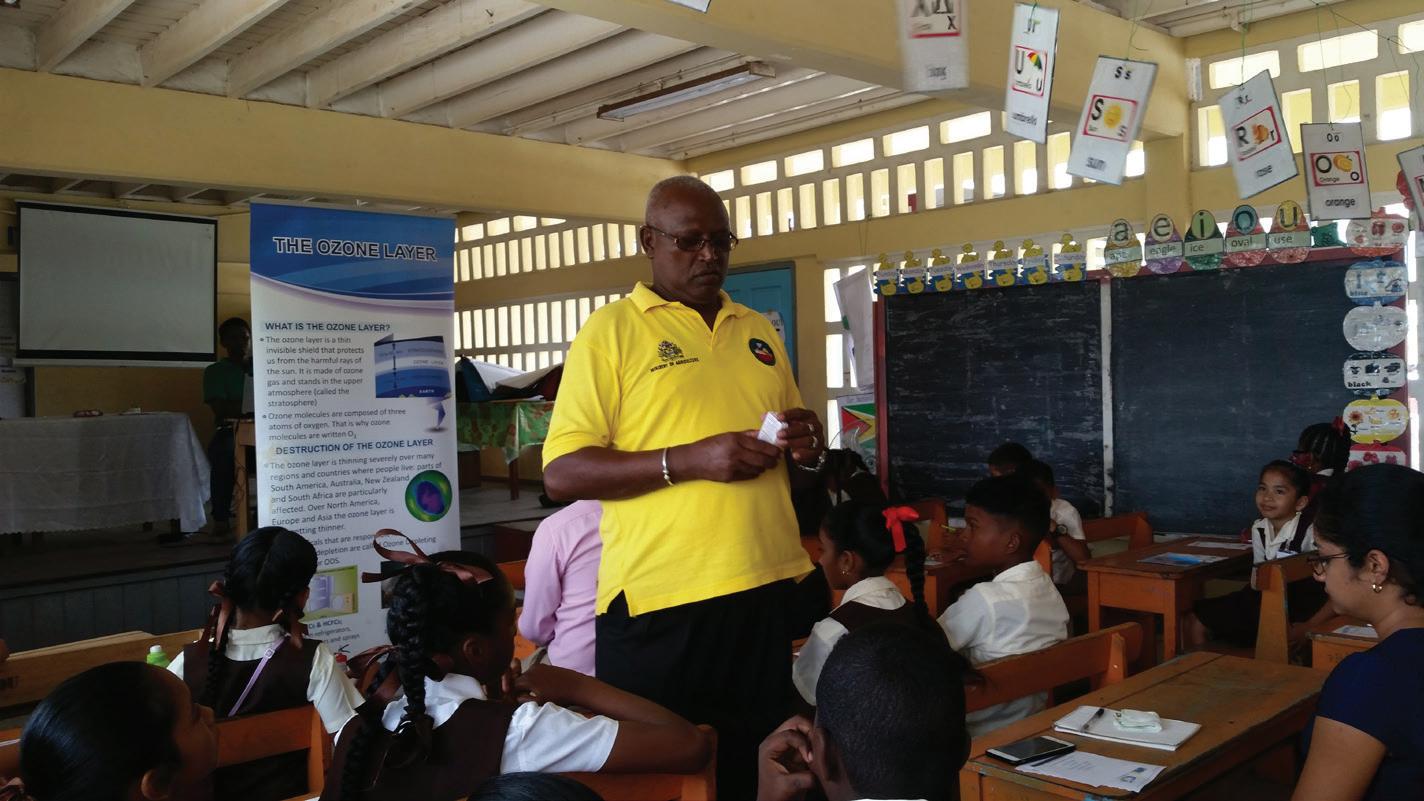
Many of us might not understand how important the ozone layer is to our planet, so that is why we should take more care of our environment so we don’t deplete our ozone layer even more.
How can we help the government to save the ozone layer?
Conserve energy -- at home, at work, everywhere;
Look for the ENERGY STAR label when buying home or office equipment;
Carpool, use public transportation, bike, or walk whenever possible;
Follow gasoline refuelling instructions for efficient vapour recovery, being careful not to spill fuel and always tightening your gas cap securely;
Consider purchasing portable gasoline containers labelled “spill-proof,” where available;
Keep car, boat, and other engines properly tuned;
Be sure your tyres are properly inflated;
Use environmentally safe paints and cleaning products whenever possible;
Mulch or compost leaves and yard waste; and
Consider using gas logs instead of wood.
Educate ourselves on the topic- reading on these topics will encourage us to take better care of our planet for our future generations.
You can share your ideas and questions by sending letters to: “Our Earth, Our Environment”, C/O Communications Department, Environmental Protection Agency, Ganges Street, Sophia, GEORGETOWN, or email us at: eit.epaguyana@gmail.com. Follow us on Facebook and Instagram and subscribe to our YouTube channel.
FROM PAGE XVI


AFTER completing one’s tertiary education and entering into the workforce of choice—many may think that’s the end of the road. That shouldn’t always be the case. I believe in self-improvement and continuous self-growth. We must understand the importance of being able to improve one’s own self. Professionally, there’s always room for growth; if there’s no room for growth, you can create it for yourself
as well. With that in mind, when we speak of continuing educational or career-centred development after someone has entered the workforce, we’re speaking of Professional Development. It doesn’t matter how long you’ve been in the said field or how experienced you are; you should not be stuck or stagnated in your knowledge base.

Professional development involves in-house company/
agency training or initiatives taken by yourself related to skills training, workshops, or classes. Whether a certificate is given after the training or session—it should not matter. What matters most is how you continually strive to improve yourself in your existing career. Professional development helps you in your existing career or job and provides you with new or better opportunities. It pays to be specialised—not only with
money but also with recognition and better opportunities. Develop specialised skills unique to you in your field of work. You’d most likely be a highly favoured and qualifying candidate for promotions or better positions at a different company/agency. Some jobs may provide in-house training, but not everyone is so lucky. As such, you should be able to create your own learning experience if none is available in your scope of work.
Professional development helps to boost your confidence and gives you the ability to become the best professional version you wish yourself to be. By learning more skills and traits, you can become even more competent and knowledgeable about your career and roles.
As you attend professional development sessions in and outside of work, you’d also have the opportunity to network with others in your field as well. It’s always good to network as a professional because you never know when you’ll need help, assistance or guidance from one of your networking partners or colleagues. Simple feedback or constructive criticism can also be deemed professional development—if you use it wisely to further improve yourself and your capabilities.
It’s important to note that you don’t always have to invest heavily in your professional development experience. You can always try to read books, attend workshop sessions, understudy/be mentored by supervisors and participate in volunteering opportunities. Time is important when developing a career and goals. As such, you ought to be aware of what it is you really want to do and the type of skills that require you to get there. I encourage you all to further develop your skills and experience. Build on your CV/ resume and always remember that there’s no such thing as too much education. Your degree or certifications may get you into the job, but professional development allows you to further advance and improve your capabilities.









































Dear Student, Welcome dear friend.
Being better at reading and vocabulary requires certain crucial skills and strategies. For instance, for analysing a character in a play, observe what he says and does. Look for statements of fact and details about him that reveal underlying ideas and attitudes. Analyse his treatment of other characters, also his reaction in various situations. Draw conclusions by making connections among these pieces carefully. Very soon a clear pattern of his character will emerge. Be wise.
Love you.
THE PASSAGE
Finding a solution to a problem
After you read the passage go ahead to use the information contained in it to solve a problem.
You arrive in a strange country where, you are told, two very distinct groups of people live: one group always tells the truth, the other always lies. There are many things you want to know about the country, but of course, first of all, you want to make sure that you can believe the person who will answer your questions. In other words, you must find someone who always tells the truth.
Suddenly you see two persons working in a field. You ask one of them to come and say to him: “Go and ask your friend over there if he tells the truth.” When the man comes back, he says: “My friend says he always tells the truth.”
Can you trust the messenger? Or is he one of those who always lie?
Hint: You need to comprehend the text in detail. Check the text constantly to work out the solution. If a solution is actually found it is proof in itself that the passage has been understood.

To paraphrase is to restate a text in your own words. Also, to make a summary or recapitulate a piece of literature. This is not to enhance the work but to say what it is about in the simplest form.
The most logical way to paraphrase a line or passage, is to reread the text in order to clarify the writer’s meaning. Look at his ideas in it. Also, read the text according to punctuation to help you pull complete thoughts together properly.
Read the selection. Then answer the questions.
Sherlock Holmes and I had no difficulty in engaging a bedroom and sitting room at the Crown Inn. They were on the upper floor, and from our window we could com-
mand a view of the avenue gate, and of the inhabited wing of Stoke Manor House. At dusk we saw Dr. Grimesby Roylott drive past … The boy had some slight difficulty in undoing the heavy iron gates, and we heard the hoarse roar of the doctor’s voice and saw the fury with which he shook his clinched fists at him.
(From “The Adventure of the Speckled Band” by Sir Arthur Canon Doyle)
1. In sentence 1, which word could replace ‘engaging’?
A buying B marrying C seeing D getting
2. Which word could replace ‘command’ in sentence 2?
A order B deserve C have D direct
3. Which best restates sentence 2?
A We saw the gate and part of the mansion.
B Our rooms had a good view. C Views from above were best.
D We saw the gate, not the mansion.
4. Which is the best paraphrase of sentence 4?
A The doctor helped at the gates. B The boy left before finishing.
C When the boy could not open the gates, Dr. Royland became angry.
D He asked for help.
Analysing and interpreting the poem
To understand the multiple meanings of a poem, readers must examine its words and phrasing from the perceptions of its rhythm, sound, images, obvious meaning, and implied meaning.
The Loveliest of Trees - By A.E. Housman Loveliest of trees, the cherry now Is hung with blossom along the bough, And stands about the woodland ride Wearing white for Eastertide.
Now, of my threescore years and ten, Twenty will not come again.
And take from seventy springs a score, It only leaves me fifty more.
And since to look a thing in bloom
Fifty springs have little room, About the woodlands I will go
To see the cherry hung with snow.
1a) How old is the speaker in stanza 2?
b) What do lines 7-8 mean?
2a) Why does the speaker say, “Fifty springs are little room”?
b) Why does the speaker go to see the trees?
3) What is the speaker’s attitude toward nature?
GRAMMAR

(Answers from last week: Being explicit): A.. The confusing phrases are all put in brackets.
1. The supervisor watched the driver pick up passengers (from the back of the bus). 2. There is a report (on the art teacher’s desk) that contains the information that we need. 3. The baking chart is on the wall (that includes all the critical dates). 4. The shopping agent bought the air frier (who was here last week). 5. Many new homeowners buy fire insurance for their houses (that they do not need). 6. My brother works for a company that repairs children’s miniature cars (two evenings a week). 7. Mr. Simon promised (after lunch) that he would instruct us on company ethics. 8. I could hear the rain scampering off the zinc sheets (while talking to my mother). 9. I could see the hospital attendant working (through my office window). 10. If you take advantage of our offer, you will receive a sturdy reading lamp that will not topple (for one thousand twenty dollars).
An outward and visible sign of an in- ward and spiritual grace.
MOST traumatic injuries to children’s teeth and supporting tissues constitute a true dental emergency and require immediate assessment and management. Injuries to the primary dentition can result in physical and emotional complications, which may persist for many years.
Depending on the type of injury, there are various consequences and prognoses for the injured tooth. These range from survival to tooth ankylosis (fusion to the bone), pulp decay, calcification, and tooth extraction.

Energy from an acute impact can easily be transmitted to the developing tooth germ because of anatomic relationships. There is also potential for periapical (root tip) complications after a primary tooth injury, which can adversely affect the developing permanent tooth.
The objective in managing a child with a history of recent trauma to the primary dentition is to ascertain the health of the succedaneous (permanent) tooth and immediately treat the injured tooth as indicated by the extent and severity of the injury. Treatment may range from “nothing” to extraction. Successful management depends on several factors, notably the child’s age at the time of the injury, the type and seriousness, and the time elapsed since the injury. The interval between injury and treatment relates to successful outcomes, minimal side effects, and pulp exposures.
The dentist who attends to children brought in for treatment for injuries sustained to the mouth generally can observe a consistent pattern. Most of the victims are boys between four and six years old. Nine out of every 10 patients are injured because of a fall. Nearly all the teeth involved in falls are not broken. However, the supporting structures suffer a high incidence of damage. There are usually almost 10 times as many injuries to the upper teeth as the lower teeth.
For the upper incisors (anterior), the most common occurrence is intrusion, in which the blow forces the teeth partially back into the bone the same way a nail is hammered into wood.
Most parents or guardians have the injured child examined and treated about 24 hours after the accident. By the time the traumatised teeth are presented for treatment, most had developed complications of which dental abscess was generally predominant. Other complications include non-vitality, discolouration, gum infection and excess mobility.
Interestingly, approximately 25 percent of the children with trauma to the teeth who were seen at the GPHC last year sustained their injuries more than four weeks before initial attendance at the hospital.
Because young teeth (three-year-olds) have immature roots and root absorption, they are less firm in their sockets, and a significant blow can easily dislodge them in any direction. The soft, resilient bone surrounding the teeth also contributes to the relative weakness.
The most crucial aspect of injury to children’s teeth is to recognise, seek and obtain adequate intervention within 12 hours after the trauma. In the initial stage, apply ice packs which will prevent or delay the acute inflammation stage (pain, swelling, bleeding, etc.) before professional help is received.
Finally, it is important to remember that children are more susceptible to emotional and psychological trauma than physical ones. You must reassure and convince the child that everything will be all right. You should also have the child checked out for any other injury besides the mouth.

